History of Vologda
Foundation of Vologda
The official year of foundation of Vologda is 1147. However, many historians and archaeologists express doubts about it and are more inclined to believe that Vologda was founded in the middle of the 13th century. In 1264, Vologda was first mentioned in written sources. The birch bark manuscript found in Vologda dates back to 1320-1340.
Until the end of the 14th century, Vologda was subordinate to the Novgorod Republic. But since the end of the 13th century, due to its favorable geographical position at the crossroads of waterways, it repeatedly became the object of wars between Novgorod, the princes of Tver and Moscow.
In 1397, the Moscow prince Vasily I by military means de facto annexed Vologda to his possessions. Under Ivan III (1440-1505), Vologda became a gathering place for troops during military campaigns, storage of the treasury and grain reserves, as well as a place of exile.
During the reign of Tsar Ivan IV (1530-1584), commonly known as Ivan the Terrible, Vologda became one of the most important transit centers in Russia’s foreign trade with England, the Netherlands, and other European countries, as well as with Siberia.
More Historical Facts…
In 1565, Ivan IV decided to turn Vologda into the capital of the Oprichnina (the first political police in Russian history) and ordered the construction of the stone Vologda Kremlin. In 1568, on the territory of the fortress, the construction of the St. Sophia Cathedral, the first stone building in Vologda, began. The construction lasted until 1570 and was carried out on the model of the Assumption Cathedral of the Moscow Kremlin.
In 1571, Ivan IV unexpectedly stopped construction work in Vologda and left it forever. As possible reasons, historians identify the abolition of Oprichnina (and, consequently, its center), the raid of the Crimean Khan Devlet Giray to Moscow, as a result of which it was almost completely burned down, and the plague epidemic.
There is also a legend that during one of his visits to St. Sophia Cathedral, a stone (or a piece of plaster) fell from its roof on Ivan IV’s head, which the tsar took as a bad sign. In support of this legend, the fact is cited that the St. Sophia Cathedral, which Ivan IV even wanted to disassemble, wasn’t consecrated during his reign. It was done only during the reign of his son Fyodor Ioannovich in 1587.
Vologda in the 17th-19th centuries
After the end of the Time of Troubles, Vologda experienced a new heyday. According to the census of 1678, the town had 1,420 households, second only to Moscow (4,845 households) and Yaroslavl (2,236 households).
During the reign of Peter I (1672-1725), Vologda, in addition to its trade and craft importance, became a major military base and a shipbuilding center. Peter I stayed in the town 5 times. The place of his stay in Vologda was the house of the Dutch merchant I. Goutman. In 1885, it was turned into the House-Museum of Peter I.
However, with the founding of St. Petersburg, which opened the sea route to Europe through the Baltic Sea, the importance of Vologda as a center of Russia’s foreign trade fell sharply. In addition, Vologda ceased to be an administrative center. In 1722, by Peter’s decree on the restriction of trade through Arkhangelsk, Vologda found itself completely aside from trade routes and turned into an ordinary provincial town.
Some revival came under Catherine II, who made Vologda the center of Vologda Viceroyalty in 1780. In 1791, the Russian writer and traveler Peter Chelishchev recorded that there were 8,156 people in Vologda, 1,572 wooden and 38 stone houses, 49 stone churches, 129 shops, and 72 manufactories. In 1796, by the decree of Paul I, Vologda Viceroyalty was renamed into Vologda Governorate.
The new economic growth of Vologda was associated with the launch of the Mariinsky and Severo-Dvinskaya water systems, steamship traffic along the Sukhona River, and with the construction of a railway line connecting Vologda with Yaroslavl and Moscow (1872), with Arkhangelsk (1898), with St. Petersburg and Vyatka (1905).
In 1871, entrepreneur Friedrich Bouman opened the first Russian specialized butter factory in the village of Marfino of the Vologda county, and in 1872, another butter factory in the nearby village of Fominskoye (13 km from Vologda). Vologda became the center of the Russian dairy industry, and “Vologda butter” became a global brand.
Vologda continued to be a place of exile and received the nickname “near-capital Siberia” in the 19th century. In the late 19th and early 20th centuries, such famous figures as I.V. Stalin, V.M. Molotov, N.A. Berdyaev, B.V. Savinkov, M.I. Ulyanova, A.V. Lunacharsky, and A.A. Bogdanov were in exile in Vologad. According to rough estimates, a total of about 10 thousand people passed through the Vologda exile.
According to the First All-Russian Census of 1897, 27,872 people lived in Vologda. At the turn of the 19th and 20th centuries, a power station, a water supply system, and a telephone station were built. Traditional folk crafts continued to develop, primarily lace-making. In 1912, there were up to 40,000 lace makers in the vicinity of Vologda.
Vologda in the 20th century
Soviet power in Vologda was established in January 1918. In February 1918, Vologda became the “diplomatic capital of Russia” for several months. Fearing the capture of Petrograd (St. Petersburg) by German troops, about 11 embassies, consulates and diplomatic missions headed by the US ambassador David Rowland Francis were evacuated here. On July 24, 1918, under pressure from the Bolsheviks, diplomats were forced to leave Vologda. During the Russian Civil War, due to refugees, the military, the migration of peasants, the population of Vologda at times reached 60,000 people.
In 1929, Vologda lost its status as a regional center for some time. In the 1930s, industrialization took place in the city: a flax mill, a plant for the manufacture of sawmill equipment “Northern Kommunar”, a garment factory named after Clara Zetkin, and other plants. In 1931, the Oktyabrsky Bridge, the first stone bridge across the Vologda River, was opened. In 1937, a separate Vologda Oblast was established again.
By the beginning of World War II, about 100,000 people lived in Vologda. During the war, the city turned into a large evacuation (mainly for residents of besieged Leningrad) and hospital center. In the winter and spring of 1942, Vologda accepted about 550,000 refugees from Leningrad. A lot of them died of disease and exhaustion in Vologda.
In the postwar years, Vologda became a major center of mechanical engineering. The rapid growth of industry caused an intensive influx of population. In 1973, the city’s population exceeded 200,000. In 1989, the population of Vologda was about 283,000 people.
The 1990s were very difficult for Vologda, as well as for the whole of Russia. Economic and business ties changed significantly or even stopped altogether.
Vologda views
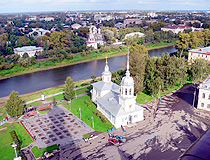
Vologda - the view from the bell tower of St. Sophia Cathedral
Author: Andrey Litvin
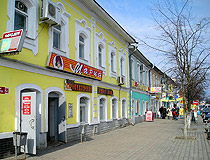
In the historic center of Vologda
Author: Aleksey Backlushin
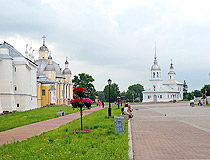
On the territory of the Vologda Kremlin
Author: Sergey Duhanin
Vologda - Features
Vologda is located on both banks of the Vologda River in the north of the European part of Russia. In addition to this river, several dozen other rivers flow on the territory of the city. Approximately 10,000 years ago, there was a glacier on the territory of Vologda Oblast, the movement of which formed a hilly landscape. One of the results of its melting is Kubenskoye Lake - the main reservoir of drinking water in Vologda.
The most popular is the version of the Finno-Ugric origin of the word “Vologda”. According to it, the name of the Vologda River, which gave the same name to the settlement, comes from the Vepsian “vouged” - “white”, the older forms of which were the words “valgeda, valkeda”. Thus, the toponym “Vologda” can be translated as “a river with clean water.”
Vologda is located in a zone of moderate continental climate with relatively warm short summers and long cold winters. The weather is unstable: thaws are possible in winter, severe frosts - in spring. The average temperature in February is minus 10.8 degrees Celsius, in July - plus 18.8 degrees Celsius.
This city is a large economic center of Vologda Oblast and the Northwestern Federal District with a developed industry and a diverse range of services. The backbone of the city’s economy is industry formed mainly in the 1950s-1980s.
It is one of the largest transport hubs in the Northwestern Federal District. Federal transport corridors pass through the city: automobile and railway “South-North” (Moscow - Yaroslavl - Arkhangelsk) and the Trans-Siberian Railway (Vladivostok - Chelyabinsk - Kirov - Vologda - St. Petersburg).
Vologda is one of the cultural centers of the Russian North: civil wooden architecture, Vologda lace, stone church architecture, icon painting. Historically, the Vologda culture was formed as a fusion of Novgorod (wooden architecture), Rostov and Moscow (stone church building and icon painting) traditions, while the role of the indigenous Finno-Ugric population is small and manifests itself mainly in toponymy and folk culture.
The city has an interesting historical and architectural heritage. The historical appearance of Vologda was formed by a harmonious combination of monuments of stone and wooden architecture. With the exception of churches destroyed during the Soviet era and rebuilt squares, the historical buildings of the city center are relatively well preserved.
In Vologda, there are more than 190 monuments of architecture and history of federal significance. Among the historical cities of Russia, Vologda occupies a special place in terms of the number and importance of monuments of wooden architecture.
This city is popular with tourists due to its rich cultural and historical heritage, as well as the convenient location of the region on the tourist map of Russia. You can get from Moscow to Vologda by car in 6 hours, from St. Petersburg - in 8 hours. A weekend trip to Vologda is a good option for those who wish to fully enjoy the unique atmosphere of the Russian North.
Main Attractions of Vologda
The Vologda Kremlin - a historical and architectural ensemble located in the central part of Vologda, founded as a fortress by order of Tsar Ivan the Terrible in 1567. By the 1820s, the walls and towers of the Vologda Kremlin were dismantled. This is one of the oldest and most historically significant sights of Vologda. Sergeya Orlova Street, 15.
Saint Sophia Cathedral (1568-1570) - an Orthodox church on the territory of the Vologda Kremlin, the oldest preserved stone building in Vologda. The frescoes of the 17th century and the iconostasis of the first half of the 18th century are almost completely preserved in this cathedral. Today, it is under the jurisdiction of the Vologda State Museum-Reserve and is open to the public in the summer. On some church holidays, divine services are held in the cathedral.
The Bishop’s Court - one of the most fully preserved residences of Russian archbishops, a historical and architectural complex on the territory of the Vologda Kremlin, consisting of buildings constructed mainly in the 17th-18th centuries. The buildings of the bishop’s court are occupied by the Vologda State Museum-Reserve.
The Resurrection Cathedral (1772-1776) - a picturesque church built in the Baroque style on the territory of the Vologda Kremlin, a valuable architectural monument and a cultural object. The interior was renovated in the first half of the 19th century.
The cathedral houses the Central Exhibition Hall of the Vologda Regional Art Gallery, where old Russian art, Russian art of the 18th - early 20th centuries, Soviet and Western European art, works of Vologda artists, works of Russian original graphics of the 19th - early 20th centuries are exhibited. Kremlovskaya Square, 3.
Vologda Lace Museum. Vologda lace is a well-known tourist brand that plays a key role in the theme of many Vologda excursions along with wooden architecture. The collection of this unique museum has not only works of local artisans, but also exhibits that tell about the world history of lacemaking, magnificent costumes, home textiles, jewelry, and paintings.
There is also a shop, a cafe, a creative workshop, and a classroom here. In the shop, visitors can purchase a variety of lace products (most of the items are made in a single copy). Kremlyovskaya Square, 10.
Revolution Square - the central square of Vologda with monuments of the Soviet era: the Eternal Flame memorial and the monument to the heroes of the Civil War, a white stone obelisk, which locals call “Tooth” for its shape.
The House-Museum of Peter I - a small one-story stone building, an architectural monument of the 17th century. Peter the Great lived in this house, which belonged to the Dutch merchant John Gutman, five times during his visits to Vologda. Today, the building houses a museum founded in 1872. It was the first museum in Vologda.
The permanent exhibition has more than 100 items, including personal belongings of the first Russian Emperor, furniture and utensils from the second half of the 17th century - the beginning of the 18th century. Excursions are devoted to the reformatory activities of Peter the Great, the Northern War, as well as the history of the Vologda region during his reign. Sovetskiy Avenue, 47.
Museum “Vologda Exile”. In pre-revolutionary Russia, Vologda was one of the places where political prisoners were exiled. In 2007, a museum dedicated to these events was opened in a wooden house on Maria Ulyanova Street, 33. The building is notable for the fact that Joseph Stalin, who was in exile, lived here for several months in 1911-1912. The exposition tells about famous political prisoners and their activities.
The Red Bridge Gallery - an art museum with works by artists of various styles: representatives of realism, underground, symbolism, and other progressive trends. In addition to paintings, photographs and modern art objects are exhibited here. In total, the collection has about 1,000 exhibits. The museum regularly hosts temporary exhibitions of local, Russian and foreign artists. Naberezhnaya 6 Armii Street, 143.
Center for Folk Arts and Crafts “Carved Palisade”. This center hosts lectures on topics related to the folk culture of the Vologda region, historical and archaeological discoveries; personal and thematic exhibitions of artists; master classes on patchwork, traditional dolls, lace-making, birch-weaving, carving, and painting on wood, ceramics, etc.; concerts of Vologda performers of folk songs. Here you can also find a permanent exhibition of folk arts and crafts and a shop with a great selection of handmade designer souvenirs. Zasodimskogo Street, 5.
Cathedral of Constantine and Helena - a beautiful Orthodox church built in the style of Moscow architecture - Russian ornamentation, circa 1690, one of the best architectural monuments of the 17th century. The church has icons of the 15th-18th centuries. Pobedy Avenue, 85.
Spaso-Prilutsky Monastery - one of the oldest and largest monasteries in the Russian North, a complex of architectural monuments of the 16th-18th centuries, including the five-domed Spaso-Preobrazhensky Cathedral (1537-1542). A bus ride to the monastery from the center of Vologda takes about 20 minutes. Monastyrskaya Street, 2.
Vologda wooden architecture - a group of urban planning styles (Art Nouveau, Classical and Empire) that prevailed in urban planning in the late 18th - early 20th centuries. The wooden houses built during this period in Vologda are reasonably well preserved. Today, there are more than 100 of them, many of them are important architectural monuments. The most interesting ones are the Puzan-Puzyrevsky House (Herzen Street, 35), the Zasetsky House (Leningradskaya Street, 12), the Samarin’s Merchant House (Sovetskiy Avenue, 16a).
Architectural and Ethnographic Museum of Vologda Oblast - a monument of all-Russian significance located in the village of Semonkovo, about 13 km north-west of the center of Vologda. The museum covers an area of 12.7 hectares. On its territory there are monuments of wooden architecture that date back to the middle of the 19th - beginning of the 20th centuries.


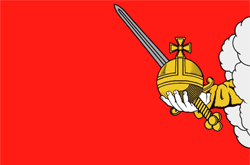
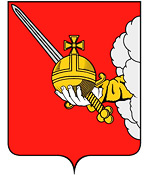
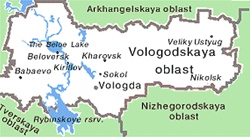



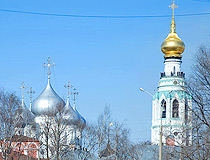
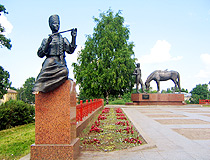
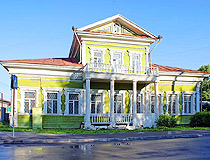
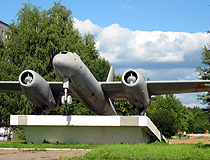
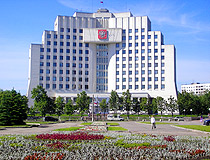
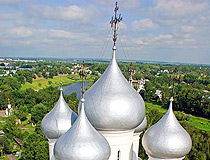
The comments of our visitors